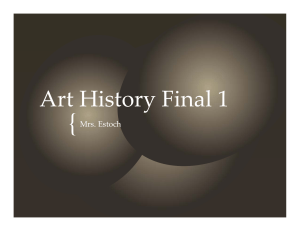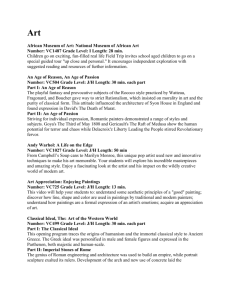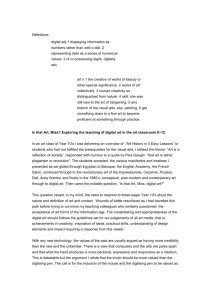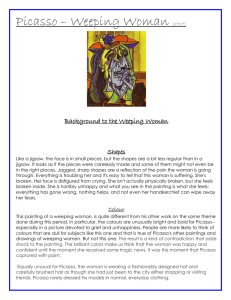American Gothic - West Northfield School District 31
advertisement
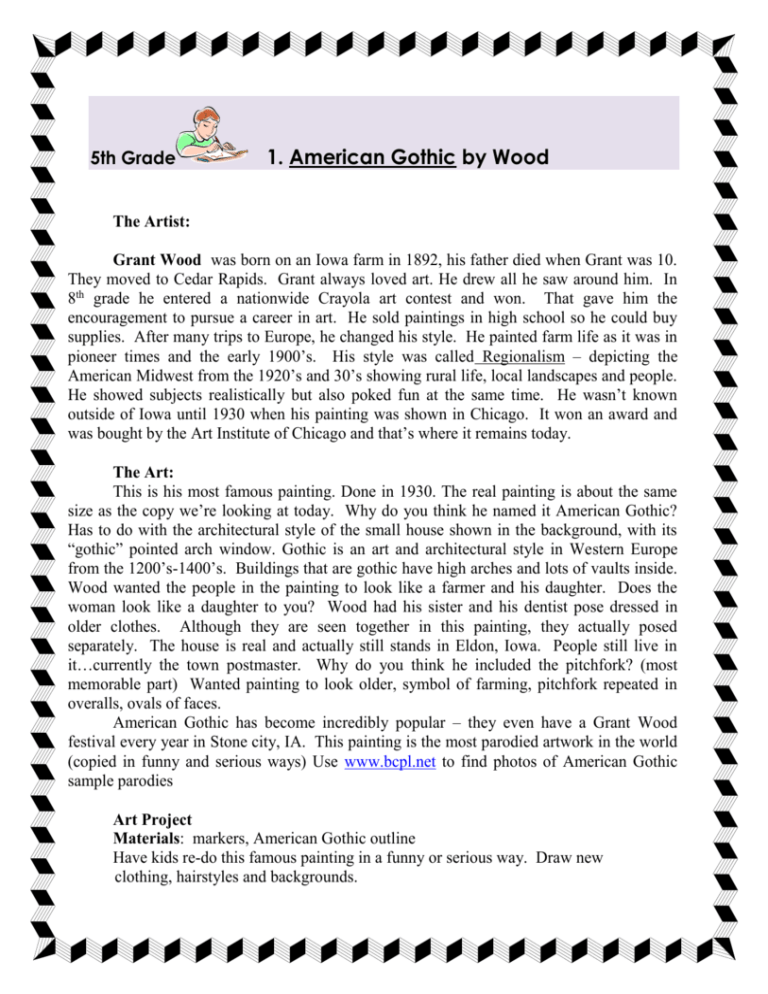
5th Grade 1. American Gothic by Wood The Artist: Grant Wood was born on an Iowa farm in 1892, his father died when Grant was 10. They moved to Cedar Rapids. Grant always loved art. He drew all he saw around him. In 8th grade he entered a nationwide Crayola art contest and won. That gave him the encouragement to pursue a career in art. He sold paintings in high school so he could buy supplies. After many trips to Europe, he changed his style. He painted farm life as it was in pioneer times and the early 1900’s. His style was called Regionalism – depicting the American Midwest from the 1920’s and 30’s showing rural life, local landscapes and people. He showed subjects realistically but also poked fun at the same time. He wasn’t known outside of Iowa until 1930 when his painting was shown in Chicago. It won an award and was bought by the Art Institute of Chicago and that’s where it remains today. The Art: This is his most famous painting. Done in 1930. The real painting is about the same size as the copy we’re looking at today. Why do you think he named it American Gothic? Has to do with the architectural style of the small house shown in the background, with its “gothic” pointed arch window. Gothic is an art and architectural style in Western Europe from the 1200’s-1400’s. Buildings that are gothic have high arches and lots of vaults inside. Wood wanted the people in the painting to look like a farmer and his daughter. Does the woman look like a daughter to you? Wood had his sister and his dentist pose dressed in older clothes. Although they are seen together in this painting, they actually posed separately. The house is real and actually still stands in Eldon, Iowa. People still live in it…currently the town postmaster. Why do you think he included the pitchfork? (most memorable part) Wanted painting to look older, symbol of farming, pitchfork repeated in overalls, ovals of faces. American Gothic has become incredibly popular – they even have a Grant Wood festival every year in Stone city, IA. This painting is the most parodied artwork in the world (copied in funny and serious ways) Use www.bcpl.net to find photos of American Gothic sample parodies Art Project Materials: markers, American Gothic outline Have kids re-do this famous painting in a funny or serious way. Draw new clothing, hairstyles and backgrounds. 5th Grade 2. Waterloo Bridge 1903 by Monet Impressionism and Claude Monet During the late 1860s and the 1870s, a group of artists developed a style of painting referred to as impressionism. Impressionism departed radically from existing traditions of European art. These impressionist artists rejected the notion that high art should represent elevated subjects from mythology, history, or religious sources. These avant-garde artists turned their attention to the people, sites, and scenes of their own age. The impressionists wanted to capture momentary effects: the flux and movement of modern life, the fleeting properties of light on forms in nature. They devised new techniques of painting to achieve this aim. Their broken brushwork, irregular surfaces, heightened color, and sense of spontaneity gave physical expression to their perceptions of a particular time and place. Their contemporaries regarded the paintings as crude and sketchy. At the first public exhibition of these works, the artists were disparagingly called mere “impressionists” by the conservative art critic Louis Leroy. By the 1880s, the diverse artists most closely associated with impressionism moved into other modes of painting. Auguste Renoir went to Italy and was inspired by works of the Renaissance to adopt a more classical style. Camille Pissaro experimented with neoimpressionism, whose adherents explored color theory and other scientific bases for their art. And Monet began to explore the same subject repeatedly in what are known today as his series paintings: haystacks, poplar trees, Rouen Cathedral, and other subjects, some near his home, others in places where he traveled, such as England, Norway, and Italy. Finally in the last decades of his life, Monet devoted his entire artistic attention to the lily pond in the garden he created in Giverny. He began to show more interest in the painted surface itself. He painted landscapes with varying brushstrokes in response to the different textures they portray. For example, the quick horizontal skips in the river’s gently rippled surface contrast with the rounder swirling forms of the sky. In the foreground exuberant strokes draw our attention to the subjects. The strokes assume an importance in their own right, becoming decorative as well as descriptive. Monet, however, never strays far from the natural forms that were his inspiration. The series pictures diverged from the spontaneity of earlier impressionist work. Though Monet began them in front of his subject—often working on several canvases simultaneously—he spent many long hours reworking them in his studio, sometimes over a period of years. As a younger man, he had sought to capture the visual effects of light and weather by painting quickly and directly outdoors, but later he pursued the most ephemeral effects slowly and with deliberation. Color, texture, and the moods they could produce assumed as great an importance in his work as the paintings’ subject, be it cathedral, river, or his beloved garden. Monet also sought to unify works in his mult-canvas series, bringing them into a whole, a goal most important to him in his late water lily pictures. Although today Monet is regarded as the most well known Impressionist artist, he spent many years of his career living in dire poverty. This was difficult on his family. Some art dealers, especially Durand-Ruel, supported him financially. Very gradually, a market developed for his Page 2 Waterloo Bridge 1903, by Monet pictures. In 1883, Monet earned enough money to move to Giverny, west of Paris. In 1890 he managed to buy the house he had been renting. The gardens of his home provided constant inspiration for his work at home. Shortly before his death in 1926 he finished his water lilly paintings. His late work is considered to be the precursor for the abstraction of the 20th century. The Art Waterloo Bridge Prints These series of prints provide a panoramic sweep of the Thames River. With their smokestacks, barge traffic, and busy bridges, Monet’s London paintings were emphatically urban—the only urban subjects he painted after the 1870s. When he returned to France, he moved from Paris to the countryside, where he preferred to live. His interest in London was the light-filtering fog. By the 1890s, paintings of the London for were an established and popular subject among artists. Most artists used a subdued palette and a limited range of colors to reproduce the grayness of the city. Monet’s London paintings are quite different. Even in these subjects dulled by fog and coal dust, he perceived color in every form. Drifting mists are painted with delicate shades of lilac and pink, and the sky is tinged with pale olive. The shaded arches of the bridge are darkened with blues, not black, and its traffic is highlighted with brilliant flecks of scarlet. Claude Monet constantly complained about the weather in his letters to Alice from London. The fog, the rain, and the damp all threatened to impede his progress, and he often worked in his hotel room, looking out the window. But the volatility of the weather that frustrated him also inspired him, and he soon had a canvas representing every type of weather. Art Project Materials needed: pencil, pastels, 2-3 sheets of construction paper per student. Walk to the window of your classroom with pencil and paper on hard surface. Using a variety of light strokes and shading, very quickly sketch the scene you see out your window. Go back to your desk, take a new sheet of paper and use pastels to re-draw the same picture. Again, remember to use strokes that capture the movement, choppy grass close to the foreground, whispy circular motions for clouds or trees in the distance. Optional: take a 3rd sheet of paper and re-draw something specific from this scene that inspires you, such as a tree, a car, a bird, a patch of grass, you may draw it from a different perspective now. 5th Grade 3. Portrait of the Artist’s Son, Titus by Rembrandt The Artist: Rembrandt Harmenszoon van Rijn (1606 – 1669) was a Dutch painter and etcher. He is generally considered one of the greatest painters and printmakers in European art history and the most important in Dutch history. His contributions to art came in a period that historians call the Dutch Golden Age. Having achieved youthful success as a portrait painter, his later years were marked by personal tragedy and financial hardships. Yet his etchings and paintings were popular throughout his lifetime, his reputation as an artist remained high, and for twenty years he taught nearly every important Dutch painter. Rembrandt's greatest creative triumphs are exemplified especially in his portraits of his contemporaries, self-portraits and illustrations of scenes from the Bible. Also notable are his dramatic and lively presentation of subjects, devoid of the rigid formality that his contemporaries often displayed, and a deeply felt compassion for mankind, irrespective of wealth and age. His immediate family—his wife Saskia, his son Titus and his common-law wife Hendrickje—often figured prominently in his paintings, many of which had mythical, biblical or historical themes. The Art: The boy in the painting has often been identified as Rembrandt's son, Titus, because his face is rendered in sensitive, intimate detail, as if depicting a beloved family member. Although research suggests otherwise, the painting is still often called Titus. A mysterious animal, perhaps a pet, sits on the boy's shoulder. Some experts identify it as a parrot, others, a monkey. According to Arthur K. Wheelock, Jr., National Gallery of Art curator of northern baroque painting, it may be that the unfinished, cut-down painting is related to an anecdote described by the Dutch theorist Arnold Houbraken in his early 18th-century biography of Rembrandt: The artist, while painting a group portrait of a husband, his wife, and their children, decided to include an image of his pet monkey because it had just died and he had no other canvas on which to paint it. The family objected and the group portrait was left unfinished. Although Houbraken's anecdotes may not be entirely accurate, this one may account for the curious animal on the boy's shoulder and the unfinished character of this remarkable image. The boy's pose and costume are reminiscent of those in Hans Holbein the Younger's Edward VI as a Child, probably 1538, and a work that Rembrandt could have seen in Amsterdam in the mid-1640s. Art Project: Using colored pencils, draw a portrait of yourself or someone you love in a professional setting, for example, you may try to draw your sister’s face in a portrait of a clown, or your uncle’s face in a portrait of an airline pilot. You may incorporate a picture of your pet or your favorite animal in the picture. 5th Grade 4a. Three Musicians 4b. Dance of Youth by Picasso Page 1 of 2 The Artist: Pablo Ruiz Picasso (1881-1973) Spanish-born painter, draftsman, and sculptor, lived most of adult life in France. His full name is Pablo Diego José Francisco de Paula Juan Nepomuceno María de los Remedios Cipriano de la Santísima Trinidad Clito Ruiz y Picasso. Around 1901, he shortened his signature to "Picasso". He is best known as the co-founder of cubism. Cubism is when the artist breaks up objects and re-assembles them in abstract and geometric form. Pablo Picasso created over 20,000 pictures. In 1891, Pablo moved with his family to Northern Spain, where his father taught art at the Instituto da Guarda. One year later, Pablo studied at this institute. After continuing to study art in Madrid, Picasso made his first trip to Paris in 1900, then the art capital of Europe. There, he met his first Parisian friend and roommate, the journalist and poet Max Jacob, who helped Picasso learn the language and its literature. These were times of severe poverty, cold, and desperation. They burned much of their work in order to keep the small room warm. Picasso demonstrated uncanny artistic talent in his early years, painting in a realistic manner through his childhood and adolescence. During the first decade of the twentieth century his style changed as he experimented with different theories, techniques, and ideas. His revolutionary artistic accomplishments brought him universal recognition and immense fortune throughout his life. He is one of the best-known figures in twentieth century art. He was 90 years old when a number of his works were shown in an exhibition at the Louvre in Paris. He was the first living artist to have an exhibition at the Louvre. Picasso had four children with three women. The Art: 4a. Three Musicians Picasso actually created two (2) similar collage and oil paintings which exemplify the Synthetic Cubist style. Cubist art takes objects, analyzes and breaks them into clusters, and then reassembles them in an abstract manner that depicts the art from different viewpoints. This avant-garde, innovative art movement, was pioneered by Georges Braque and Pablo Picasso. Cubism revolutionized European painting, sculpture, and inspired related movements in architecture, music, and literature. It is considered the most influential art movement of the 20th century. Both Three Musicians were completed in 1921 in Fontainebleau near Paris. One version is owned by New York City’s MoMA (Museum of Modern Art). The other is in the Philadelphia Museum of Art. Each painting features a Harlequin (talented performing clown), a Pierrot (mime/comedian), and a Monk, who are believed to be based on Picasso and his two poet friends, Guillaume Apollinaire, and Max Jacob. Jacob actually entered a monestary in 1921. 4b. Dance of Youth This Artwork, also known as Dance of Friendship and La Ronde, was carved in stone in 1961 to create 200 signed lithographs. The lithographs were designed as messages of peace. What would you imagine the subjects in this artwork are feeling and thinking? Are they worried about life or celebrating life? How many colors do you see? Why do you think he chose primary colors? What do you see that would symbolize peace? What is a 5th Grade, Picasso, Page 2 of 2 white dove symbolic of? Why didn’t he use a black crow? What tree branch has been used for thousands of years to symbolize peace? (Olive branch in ancient Greece, Roman-Greco mythology, Noah’s Ark.) When Picasso created this art in 1961, who was making speeches about peace and equality in the U.S.? (MLK “I have a dream’ speech 1963. Civil Rights Movement 1955-1968.) Is this artwork serious and heavy or light and carefree? Peace can mean many things. What do you think it means to people your age? What was Picasso’s message? Art Projects: Both projects are to be completed quickly. Materials: 5 pieces of white paper per student, colored pencils, pen. First Project, Gesture Sketching: Class instructions: This is so easy, that it’s hard. Gesture Sketching captures the fluidity and motion of a pose. Using a pen, (no pencils) you will have only 30 seconds to quickly draw several persons—think stick figures. This means you have only 10 seconds to capture each person’s posture. Art parent instructions: Ask 1/3 of the class to come to the front or center of class, and stand in a straight line. When you say go, they must immediately ‘strike a pose’ that they will hold (like freeze dance) for at least 30 seconds. The seated students now have less than a minute to draw this group. Then, they sit down, and the next third of class takes a turn posing. And then the final group. Second Project, Cubism Artwork: Draw a tree, grass, and sky in chunky sections, using only colorful cubes and geometric shapes. Fill your entire sheet of paper with color. Pablo Picasso 1881-1973 5th Grade 5. Creation of Adam by Michelangelo Page 1 of 2 The Artist Michelangelo di Lodovico Buonarroti Simoni (1475-1564), commonly known as Michelangelo, was an Italian Renaissance painter, sculptor, architect, poet, and engineer. His talents were so refined and versatile, that he is considered the archetype of the Renaissance genius. His talents transcend time and continue to influence and inspire contemporary artists. Born in Italy, Michelangelo came from a family of bankers, although his father’s bank was unsuccessful. Hence his family was poor and his years at home were very hard. His mother was ill frequently and died when he was only 6 years old. Michelangelo became sad, and was known to have a brooding and difficult personality throughout his lifetime. He was sent to live with a family who cared for him in the beautiful Italian countryside. His talents were revealed from a very young age. At the age of 13, he was apprenticed to a successful painter who taught him to draw and paint. After a year he was transferred to the sculpture academy in Florence, Italy. The Medici Family were in power, and Lorenzo Medici invited him to live in the palace and be educated by the most brilliant scholars of the time. There he gained an appreciation for classical sculpture and humanist philosophy that shaped and influenced his work. After the death of his patron, Lorenzo de Medici, the artist traveled to Bologna and Rome, continually refining his brilliant technique and establishing his reputation as a dominant force in the arts. By the age of 30 he sculpted David, which stands in Florence. He was picked to design the Pope’s tomb, which he worked on for 40 years but never finished. In the mean time he also painted the ceiling of the Sistene Chapel, which is regarded as one of the greatest masterpieces of painting in history. He also carved tombs for the Medici family, designed a library. He was the chief architect of St. Peter’s in Rome. He was the first artist to have his biography published during his lifetime. Christopher Columbus made his voyage during Michelangelo’s time and the year of the artist’s death was the year of Shakespeare’s birth. The Art: Creation of Adam (fresco from the ceiling of the Sistine Chapel) The Creation of Adam is one of the most well-known and famous artworks of all time, and as such has been the subject of a number of references and parodies. The Sistine Chapel is the official residence of the pope in Vatican City. It takes its name from Pope Sixtus IV who rebuilt the Chapel. It is famous for its design, after Solomon’s Temple of the Old Testament and for being frescoed by many of the greatest Renaissance artists. 5th Grade, Michelangelo, Creation of Adam Page 2 of 2 In May of 1508, Michelangelo accepted a commission from Pope Julius II to repaint the Vatican's Sistine Chapel’s 12,000 sq ft ceiling. Initially, Michelangelo was reluctant to accept the commission, regarding himself a sculptor, but his initial trepidations faded and he began the project in early 1509. Using the centuries-old technique of fresco, Michelangelo worked at a feverish pace under exceptionally adverse conditions. The ceiling decoration devised by Michelangelo consisted of a series of illusionistic architectural elements that frame figures and narrative scenes derived from the Old Testament. Completed four years later in 1512, the ceiling marked the summit of the artist's career as a painter and sealed his reputation as the greatest painter of the High Renaissance. The ceiling of the Sistine Chapel is considered the most influential work in fresco painting in the history of Western art. He worked ‘buon fresco’, meaning he painted directly on the freshly laid plaster and did not come back later to add details. He used bright colors that were easily visible from the floor. The controversial restoration of the ceiling, begun in 1980, has dramatically transformed its appearance, revealing a dazzling array of color, renewing interest in Michelangelo as a colorist. In contrast to artists who appreciated nature, his figures exude the anatomy and physical strength of man as he battles the forces of nature for his existence and longevity. In order to reach the chapel’s ceiling, Michelangelo designed his own scaffold. A traditional scaffold would have been built from the floor up, calling for significant lumber costs, and prevented the use of the Chapel for services during the four year duration of the project. Michelangelo’s engineering ingenuity and creative mind provided this alternate solution. Although the artist devoted the last thirty years of his life almost exclusively to architecture, his powerful paintings remained enormously influential, and continue to stand among the supreme masterpieces of art history. Art Project: Materials needed : charcoal sticks, charcoal paper, tape, tissue/paper towel, a copy of Creation of Adam (hands detail) Students are to pull out their chair and tape a piece of charcoal paper to the bottom of their desk. Then, laying down on the ground, they are to draw their right hand outstretching to touch the left hand which has already been drawn on the paper. Using tissue/paper towel rub the charcoal to different shades of darkness. The picture of the hands from creation will provide example on where to use darker shading.
